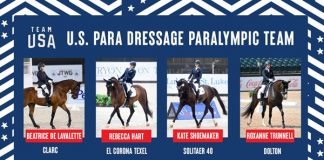Starting a green horse over jumps is much like teaching a child to read. Both require a step-by-step approach, where the student becomes proficient in one lesson before moving on to the next challenge.

If you’re working with a green hunter or jumper, think of him as an equine kindergartner. Assume the role of a teacher, and maintain a methodical mindset in your schooling sessions. You’ll be more likely to avoid most of the behavioral issues (like refusals and rushing) that can result from a horse being pushed too quickly through his training. Double-check your greenie’s progress with the following basic skills. Your horse shouldn’t graduate to imposing jumps and complicated courses until he’s mastered these ABCs:
A: Attain adjustability on the flat.
Long before cantering jumps and schooling entire courses, your greenie needs to be adjustable at all gaits. That means your horse should not only walk, trot and canter, but he should also be willing to collect or extend each of these gaits without leaning on your hands like a race horse. Needless to say, this requires that your horse understands and responds to your aids, including the all-important half-halt. Once your horse’s gaits are adjustable on the flat, he’ll be easier to ride over a course of jumps. He won’t move up (increase his pace and length of stride) on the way to a jump unless you tell him. And won’t that be nice?
B: Be confident when new jumping elements are introduced.
A green horse that bolts over unfamiliar jumps is not brave; he’s anxious and lacks confidence. So that you don’t create a horse that gets strong and quick to his jumps, introduce new obstacles—like flower boxes, panels and gates—in their smallest format. Set flower boxes at the base of a crossrail, and lean solid panels against a low vertical. Then approach them at the trot, which allows your greenie to focus on jumping the strange item. Trotting also gives you greater control over your horse’s pace and approach. Just adhere to this imperative: Do not let your greenie stop and inspect new elements. While he mustn’t leap like an antelope over strange jumps, he does have to go forward. Encourage him with a tap of the crop if necessary. He’ll gain confidence when he realizes that he can indeed jump whatever you place before him.
C: Canter low, single jumps on a consistent rhythm.
This skill is a final exam. If your greenie can maintain the same pace and length of stride throughout his approach to a jump, and then continue on the same rhythm once he lands, then you have been an excellent teacher. Your horse is confident in his job and trusts your judgment. He knows you won’t ask him to do the impossible. Your greenie is now prepared for more sophisticated lessons, like trotting into a line and cantering out over the other elements. You can also canter a short course of three or four jumps, with simple lead changes in the corners. On the other hand, if your greenie gets strong when he canters a jump, especially if he quickens the last few strides before take-off, then you have some homework to do. Resist the urge to continue on and fix this later. Remember your commitment to a methodical approach. Don’t promote your green hunter or jumper until he knows his ABCs.
Liked this article? Here’s more info on getting started jumping:
A Good Jump Start for the Young Horse
Teach Your Horse to Jump in 5 Steps
Horse Jumping Tips






I do not jump, but sure would love to learn. Any advise for a “green” rider??
great info! i wish i had this a few months ago when i started my pony over jumps. at 1st i just tried jumping over jumps straight on with no practice and she didnt do well. but then i took it slow starting with ground poles and lope poles and now she does great and actually loves it!
Excellent advice.